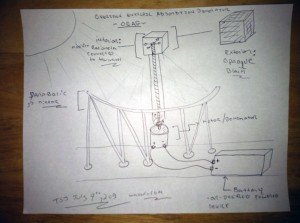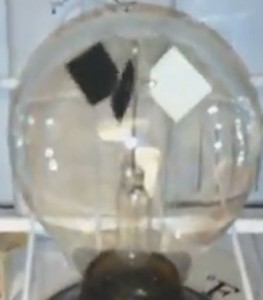After doing the brief test which is in the video below. It became evident that BOTH light and heat increase the rotational speed of the radiometer.
This led to the idea of linking a parabolic mirror to a modified radiometer which is nested inside a clear glass airtight cylinder which is nested within an opaque black metal cube.
The device will be known as the Overidon Entropic Absorption Generator (OEAG).
As you probably already know, the primary difference between a spherical mirror and a parabolic mirror has to do with the focal point of light. A spherical mirror focuses light in a very tight and general area with limited diversity of non-focused light rays.
Yet a parabolic mirror is even better for focusing light than spherical mirror because it has virtually no stray light beams at all. This is due to the fact that parabolic mirrors converge the light beams to a single point of focus. It is true, all things being equal, those light rays will eventually travel past the point of focus and go to another area. But if one places an object directly at the 3-dimensional focal point of the parabolic mirror, a maximal amount of light will be channeled to a single target area.
That is why the parabolic mirror is included as part of the design of the Overidon Entropic Absorption Generator. It increases the amount of energy introduced into the system efficiently and effectively. For the sake of future experiments, the parabolic mirror is chosen because it is much more cost-effective than its lens counterparts. A parabolic mirror can be created crudely and cheaply and still channel tremendous energy. While a lens of equivalent focusing power on the other hand, would cost tremendously more money for the experimentation process. Since the purpose of this project is to create a device which generates energy which can exceed the construction cost within a reasonable number of Kilowatt Hours, cost will be a factor and lynch-pin in every aspect of the prototype construction process.
The reason for the black cube is obvious. Black paint on metal is excellent at converting light into heat. This heat will increase the temperature of the air inside the cube. The air inside the cube will constantly touch the glass of the modified-radiometer cylinder core. The entropy within the cylinder will cause the vanes to spin. The reason why the term, “entropy” is used is because the OEAG is based on the upsetting of equilibrium within the glass cylinder. That’s what makes the whole process happen. As you’ll see in the simple radiometer video below, more light and more heat means the vanes of the radiometer spins faster. If the vanes of the radiometer spins quickly in 90 degree weather, imagine how quickly they would spin under the increased temperatures of being radiated by a parabolic mirror. This train of thought is what gives the hypothesis that heavier and more substantial vanes can be used within the cylinder core than its traditional radiometer counterparts. Also, the reason why a cylinder is being used instead of a light-bulb shape is due to again, an attempt to reduce construction costs of future prototypes.
A cylinder and a light-bulb shape both have one thing in common. Both shapes are capable of containing a toroidal system. If one is unfamiliar with a toroid, it is basically a three-dimensional doughnut shape. In fact toroids are quite common in both science and nature. A hurricane is a mixture of a spiral as well as a toroid. And of course a tornado has the word toroid within its name. The spinning toroid even has the “eye” which is analogous to the empty space within the doughnut or toroid shape.
The heat within the sealed cube will create infra-red light. This infra-red light will spin the vanes within the cylinder core. The reason for this is similar to how a radiometer will spin with the lights off in your hand is on it. The heat from your hand is still light, although that light is not visible to the human eye. In fact, if one were to wear infra-red goggles, you would see the color within a radiometer change as the temperature changes. The same principle is applied to the OEAG, the black opaque cube works as a type of filter, converting all visible light radiation directly into heat which will be transferred into the cylinder core.
Once the energy is within the core and the core begins to spin, the transversal will move a long and thin cylindrical rod down through an encapsulated shaft which goes down even below the parabolic mirror itself. Underneath the mirror will be a small hobby motor which will have its black motor head spun by the clockwise rotation of the cylinder core. The motor will be used in this prototype as a type of makeshift electrical generator. The rotational energy of the transversal rod will be converted to electricity by the motor which is actually nothing more than a rotor/stator combination which is equipped with input/output (I/O -/+) electrical wires.
After the electricity is generated, it can be transferred into a battery or else inputted into a transformer for further electrical usage. Or in some cases, the electricity may be used directly for some specific analog electrical applications.
Here is a video of how a radiometer spins faster when it is on top of a mirror in sunlight on a hot day.
I hope you enjoyed this article and if you like it feel free to share it with your friends in its entirety or in parts.
Sincerely,
-Tyler Stansfield Jaggers
Overidon Entropic Absorption Generator – (OEAG)
copyright 2013 overidon.com

